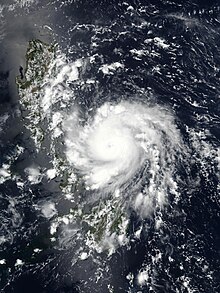 Vongfong nearing landfall on the island of Samar on May 14 | |
| Meteorological history | |
|---|---|
| Formed | May 8, 2020 |
| Dissipated | May 18, 2020 |
| Very strong typhoon | |
| 10-minute sustained (JMA) | |
| Highest winds | 155 km/h (100 mph) |
| Lowest pressure | 960 hPa (mbar); 28.35 inHg |
| Category 3-equivalent typhoon | |
| 1-minute sustained (SSHWS/JTWC) | |
| Highest winds | 185 km/h (115 mph) |
| Lowest pressure | 961 hPa (mbar); 28.38 inHg |
| Overall effects | |
| Fatalities | 5 |
| Damage | $50 million (2020 USD) |
| Areas affected | Palau, Philippines, Taiwan |
| IBTrACS | |
Part of the 2020 Pacific typhoon season | |
Typhoon Vongfong, known in the Philippines as Typhoon Ambo, was a strong tropical cyclone that impacted the Philippines in May 2020. Beginning as a tropical depression on May 10 east of Mindanao, Vongfong was the first storm of the 2020 Pacific typhoon season. It gradually organized as it took a slow northward course, strengthening into a tropical storm on May 12 and curving west thereafter. The next day, Vongfong entered a period of rapid intensification, becoming a typhoon and attaining 10-minute maximum sustained winds of 150 km/h (93 mph). The storm made landfall at this intensity near San Policarpo, Eastern Samar, at 04:15 UTC on May 14. The system tracked across Visayas and Luzon, making a total of seven landfalls. Persistent land interaction weakened Vongfong, leading to its degeneration into a tropical depression over the Luzon Strait on May 17.
Preparations for the typhoon were complicated due to the COVID-19 pandemic. Shelters that opened had to be modified in order to accommodate health guidelines and social distancing. Throughout the Philippines, Vongfong caused around ₱1.57 billion (US$31.1 million) in damage, and killed five people.[1][2]
- ^ "Sitrep No.15 re Preparedness Measures and Effects for Typhoon "AMBO" (I.N. "VONGFONG")" (PDF). NDRRMC. May 27, 2020.
- ^ "5 dead, P80 million lost in Typhoon 'Ambo' wake". Manila Standard. May 18, 2020.